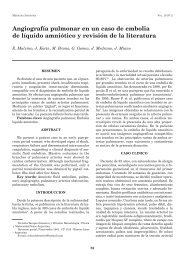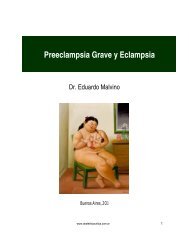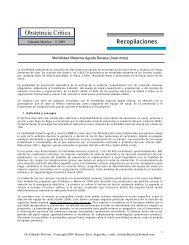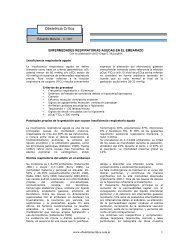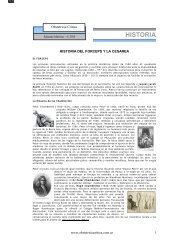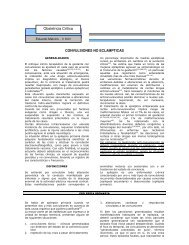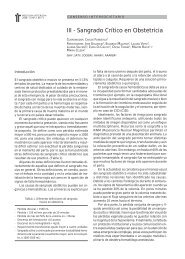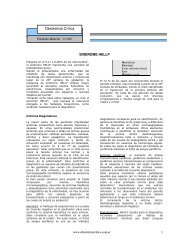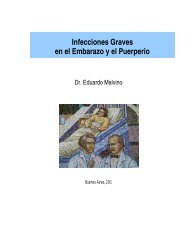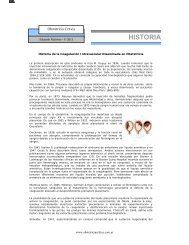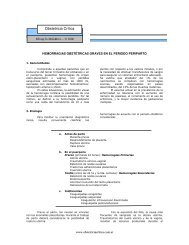Abstracts â 2008 - Obstetricia CrÃtica
Abstracts â 2008 - Obstetricia CrÃtica
Abstracts â 2008 - Obstetricia CrÃtica
Create successful ePaper yourself
Turn your PDF publications into a flip-book with our unique Google optimized e-Paper software.
Cochrane Library, Issue 3, 2005) and PubMed using multiple search termsrelated to PTB and antibiotics. Publications were limited to randomised controlledtrials comparing antibiotics with placebo given to asymptomatic non-labouringwomen. A random effect model was used, and combined risk ratios calculated forthe various risk groups. Associations between treatment effect and the rate ofPTB were analysed by meta-regression. RESULTS: Seventeen trials wereincluded, 12 identifying women at risk by abnormal vaginal flora, three on womenat high risk from a previous PTB and two recruiting women based on positivefetal fibronectin status. There was no significant association between antibiotictreatment and reduction in PTB irrespective of criteria used to assess risk, theantimicrobial agent administered, or gestational age at time of treatment (overallcombined random effect for delivery at less than 37 weeks RR 1.03 (95% CI0.86-1.24)). CONCLUSIONS: Treating women at risk of PTB with antibioticsdoes not reduce the risk of subsequent PTB.Gynecol Obstet Invest. <strong>2008</strong> Jan 14;65(4):258-261 [Epub ahead of print]Cranial Thromboembolism Secondary to Patent Foramen Ovale and DeepVenous Thrombosis after Cesarean Section.Bodur H, Caliskan E, Anik Y, Cakiroglu Y, Corakci A.Departments of Obstetrics and Gynecology, University of Kocaeli MedicalSchool, Kocaeli, Turkey.Background: Paradoxical embolism via a patent foramen ovale (PFO) is a rareevent in the puerperium as a cause of stroke. Case: We report a 21-year-old,G4P3A1 woman with the symptoms of convulsion, stroke and unconsciousness 1week after cesarean delivery. An infarction was detected in both frontal lobes,and echocardiography and MRI confirmed the PFO. Her follow-up course withlow-molecular-weight heparin and then warfarin for 6 months was uneventful.Conclusion: Patients with an unexplained arterial event should be screened forPFO and possible paradoxical embolism. Copyright (c) <strong>2008</strong> S. Karger AG,Basel.Obstet Gynecol. 2007 Dec;110(6):1270-8.Use of recombinant activated factor VII in primary postpartum hemorrhage:the Northern European registry 2000-2004.Alfirevic Z, Elbourne D, Pavord S, Bolte A, Van Geijn H, Mercier F, Ahonen J,Bremme K, Bødker B, Magnúsdóttir EM, Salvesen K, Prendiville W, Truesdale A,Clemens F, Piercy D, Gyte G.Division of Perinatal and Reproductive Medicine, University of Liverpool,Liverpool Women's Hospital, Liverpool, United Kingdom. zarko@liv.ac.ukOBJECTIVE: To collect data from nine European countries for cases of obstetrichemorrhage between 2000 and 2004 in which recombinant activated factor VII(rFVIIa) was used. METHODS: The cases were identified through nationalsurveys. Standardized case report forms included sociodemographic details, pastmedical and obstetric history, and details of the progress and management oflabor in which the postpartum hemorrhage occurred. Clinicians were asked todescribe subjectively the effect of rFVIIa administration using two mutually



